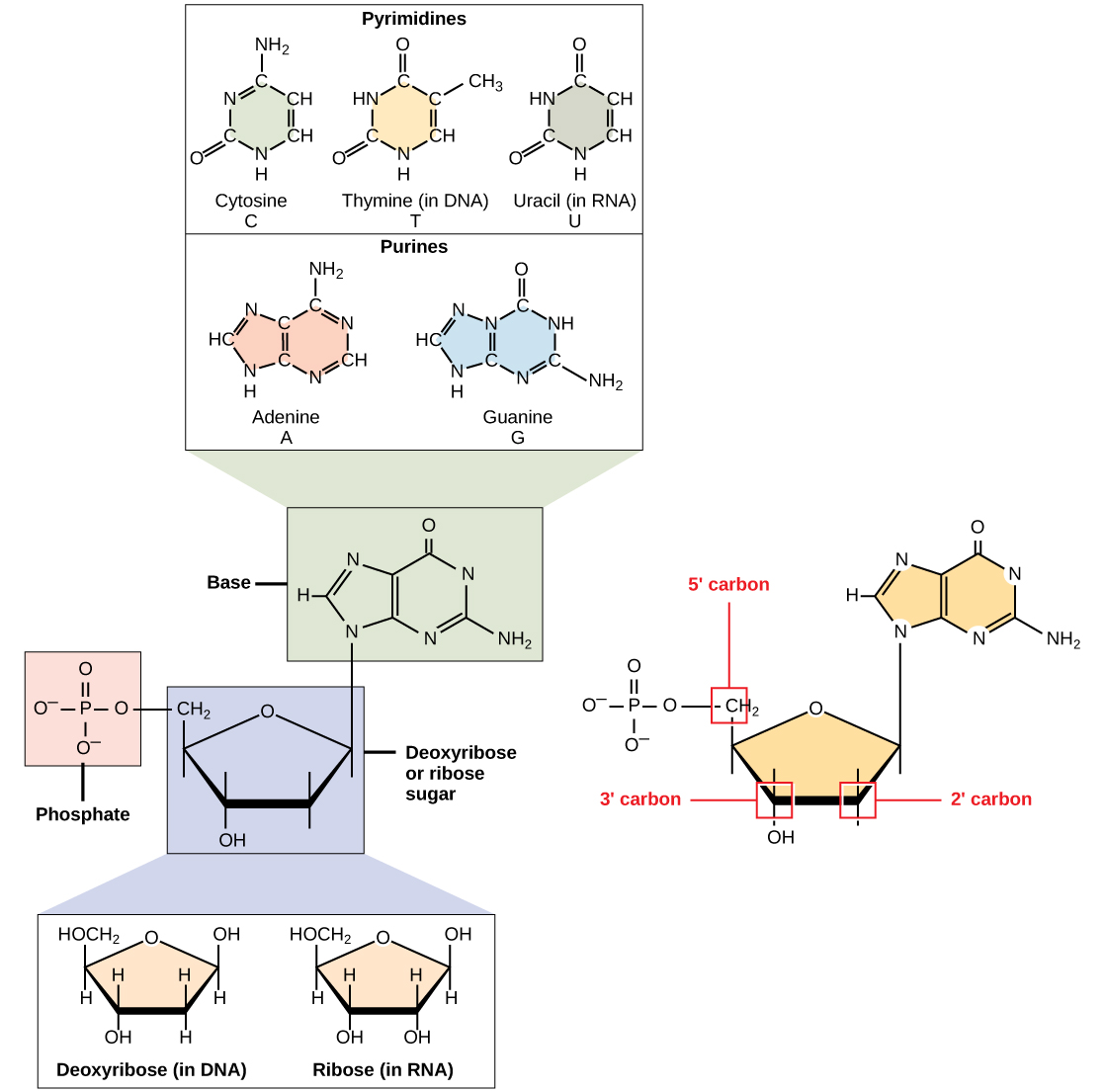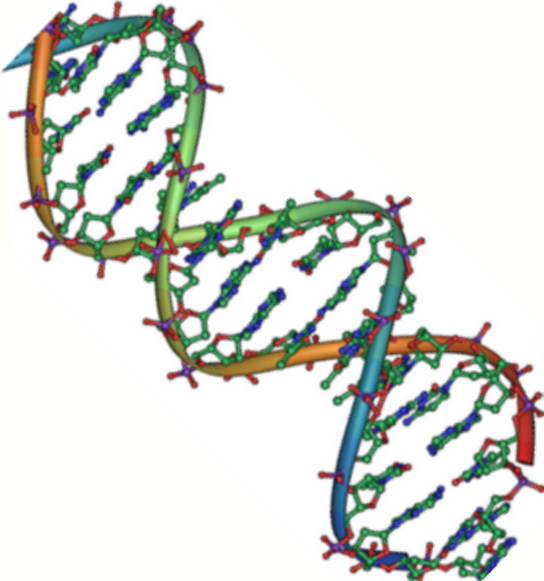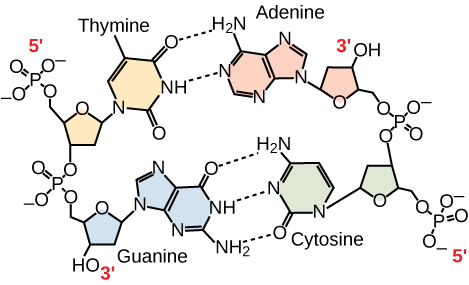86 Nucleic Acids
LumenLearning
DNA and RNA
DNA and RNA are nucleic acids that carry out cellular processes, especially the regulation and expression of genes.
LEARNING OBJECTIVES
Describe the structure of nucleic acids and the types of molecules that contain them
KEY TAKEAWAYS
Key Points
- The two main types of nucleic acids are DNA and RNA.
- Both DNA and RNA are made from nucleotides, each containing a five-carbon sugar backbone, a phosphate group, and a nitrogen base.
- DNA provides the code for the cell ‘s activities, while RNA converts that code into proteins to carry out cellular functions.
- The sequence of nitrogen bases (A, T, C, G) in DNA is what forms an organism’s traits.
- The nitrogen bases A and T (or U in RNA) always go together and C and G always go together, forming the 5′-3′ phosphodiester linkage found in the nucleic acid molecules.
Key Terms
- nucleotide: the monomer comprising DNA or RNA molecules; consists of a nitrogenous heterocyclic base that can be a purine or pyrimidine, a five-carbon pentose sugar, and a phosphate group
- genome: the cell’s complete genetic information packaged as a double-stranded DNA molecule
- monomer: A relatively small molecule which can be covalently bonded to other monomers to form a polymer.
Types of Nucleic Acids
The two main types of nucleic acids are deoxyribonucleic acid (DNA) and ribonucleic acid (RNA). DNA is the genetic material found in all living organisms, ranging from single-celled bacteria to multicellular mammals. It is found in the nucleus of eukaryotes and in the chloroplasts and mitochondria. In prokaryotes, the DNA is not enclosed in a membranous envelope, but rather free-floating within the cytoplasm.
The entire genetic content of a cell is known as its genome and the study of genomes is genomics. In eukaryotic cells, but not in prokaryotes, DNA forms a complex with histone proteins to form chromatin, the substance of eukaryotic chromosomes. A chromosome may contain tens of thousands of genes. Many genes contain the information to make protein products; other genes code for RNA products. DNA controls all of the cellular activities by turning the genes “on” or “off. ”
The other type of nucleic acid, RNA, is mostly involved in protein synthesis. In eukaryotes, the DNA molecules never leave the nucleus but instead use an intermediary to communicate with the rest of the cell. This intermediary is the messenger RNA (mRNA). Other types of RNA—like rRNA, tRNA, and microRNA—are involved in protein synthesis and its regulation.
Nucleotides
DNA and RNA are made up of monomers known as nucleotides. The nucleotides combine with each other to form a polynucleotide: DNA or RNA. Each nucleotide is made up of three components:
- a nitrogenous base
- a pentose (five-carbon) sugar
- a phosphate group
Each nitrogenous base in a nucleotide is attached to a sugar molecule, which is attached to one or more phosphate groups.

Nitrogenous Base
The nitrogenous bases are organic molecules and are so named because they contain carbon and nitrogen. They are bases because they contain an amino group that has the potential of binding an extra hydrogen, and thus, decreasing the hydrogen ion concentration in its environment, making it more basic. Each nucleotide in DNA contains one of four possible nitrogenous bases: adenine (A), guanine (G) cytosine (C), and thymine (T).
Adenine and guanine are classified as purines. The primary structure of a purine consists of two carbon-nitrogen rings. Cytosine, thymine, and uracil are classified as pyrimidines which have a single carbon-nitrogen ring as their primary structure. Each of these basic carbon-nitrogen rings has different functional groups attached to it. In molecular biology shorthand, the nitrogenous bases are simply known by their symbols A, T, G, C, and U. DNA contains A, T, G, and C whereas RNA contains A, U, G, and C.
Five-Carbon Sugar
The pentose sugar in DNA is deoxyribose and in RNA it is ribose. The difference between the sugars is the presence of the hydroxyl group on the second carbon of the ribose and hydrogen on the second carbon of the deoxyribose. The carbon atoms of the sugar molecule are numbered as 1′, 2′, 3′, 4′, and 5′ (1′ is read as “one prime”).
Phosphate Group
The phosphate residue is attached to the hydroxyl group of the 5′ carbon of one sugar and the hydroxyl group of the 3′ carbon of the sugar of the next nucleotide, which forms a 5′3′ phosphodiester linkage. The phosphodiester linkage is not formed by simple dehydration reaction like the other linkages connecting monomers in macromolecules: its formation involves the removal of two phosphate groups. A polynucleotide may have thousands of such phosphodiester linkages.
The DNA Double Helix
The DNA double helix looks like a twisted staircase, with the sugar and phosphate backbone surrounding complementary nitrogen bases.
LEARNING OBJECTIVES
Describe the structure of DNA
KEY TAKEAWAYS
Key Points
- The structure of DNA is called a double helix, which looks like a twisted staircase.
- The sugar and phosphate make up the backbone, while the nitrogen bases are found in the center and hold the two strands together.
- The nitrogen bases can only pair in a certain way: A pairing with T and C pairing with G. This is called base pairing.
- Due to the base pairing, the DNA strands are complementary to each other, run in opposite directions, and are called antiparallel strands.
Key Terms
- mutation: any error in base pairing during the replication of DNA
- sugar-phosphate backbone: The outer support of the ladder, forming strong covalent bonds between monomers of DNA.
- base pairing: The specific way in which bases of DNA line up and bond to one another; A always with T and G always with C.

A Double-Helix Structure
DNA has a double-helix structure, with sugar and phosphate on the outside of the helix, forming the sugar-phosphate backbone of the DNA. The nitrogenous bases are stacked in the interior in pairs, like the steps of a staircase; the pairs are bound to each other by hydrogen bonds. The two strands of the helix run in opposite directions. This antiparallel orientation is important to DNA replication and in many nucleic acid interactions.

Base Pairs
Only certain types of base pairing are allowed. This means Adenine pairs with Thymine, and Guanine pairs with Cytosine. This is known as the base complementary rule because the DNA strands are complementary to each other. If the sequence of one strand is AATTGGCC, the complementary strand would have the sequence TTAACCGG.
DNA Replication
During DNA replication, each strand is copied, resulting in a daughter DNA double helix containing one parental DNA strand and a newly synthesized strand. At this time it is possible a mutation may occur. A mutation is a change in the sequence of the nitrogen bases. For example, in the sequence AATTGGCC, a mutation may cause the second T to change to a G. Most of the time when this happens the DNA is able to fix itself and return the original base to the sequence. However, sometimes the repair is unsuccessful, resulting in different proteins being created.
LICENSES AND ATTRIBUTIONS
CC LICENSED CONTENT, SHARED PREVIOUSLY
- Curation and Revision. Provided by: Boundless.com. License: CC BY-SA: Attribution-ShareAlike
CC LICENSED CONTENT, SPECIFIC ATTRIBUTION
- OpenStax College, Biology. October 16, 2013. Provided by: OpenStax CNX. Located at: http://cnx.org/content/m44403/latest/?collection=col11448/latest. License: CC BY: Attribution
- genome. Provided by: Wiktionary. Located at: http://en.wiktionary.org/wiki/genome. License: CC BY-SA: Attribution-ShareAlike
- nucleotide. Provided by: Wiktionary. Located at: http://en.wiktionary.org/wiki/nucleotide. License: CC BY-SA: Attribution-ShareAlike
- monomer. Provided by: Wiktionary. Located at: http://en.wiktionary.org/wiki/monomer. License: CC BY-SA: Attribution-ShareAlike
- OpenStax College, Nucleic Acids. October 16, 2013. Provided by: OpenStax CNX. Located at: http://cnx.org/content/m44403/latest/Figure_03_05_01.jpg. License: CC BY: Attribution
- OpenStax College, Biology. October 16, 2013. Provided by: OpenStax CNX. Located at: http://cnx.org/content/m44403/latest/?collection=col11448/latest. License: CC BY: Attribution
- mutation. Provided by: Wiktionary. Located at: http://en.wiktionary.org/wiki/mutation. License: CC BY-SA: Attribution-ShareAlike
- Boundless. Provided by: Boundless Learning. Located at: http://www.boundless.com//biology/definition/antiparallel. License: CC BY-SA: Attribution-ShareAlike
- OpenStax College, Nucleic Acids. October 16, 2013. Provided by: OpenStax CNX. Located at: http://cnx.org/content/m44403/latest/Figure_03_05_01.jpg. License: CC BY: Attribution
- OpenStax College, Nucleic Acids. October 16, 2013. Provided by: OpenStax CNX. Located at: http://cnx.org/content/m44403/latest/Figure_03_05_03.png. License: CC BY: Attribution
- OpenStax College, Nucleic Acids. October 16, 2013. Provided by: OpenStax CNX. Located at: http://cnx.org/content/m44403/latest/Figure_03_05_02.jpg. License: CC BY: Attribution
This chapter is an adaptation of the chapter “Nucleic Acids” in Boundless Chemistry by LumenLearning and is licensed under a CC BY-SA 4.0 license.
A relatively small molecule that can form covalent bonds with other molecules of this type to form a polymer.

